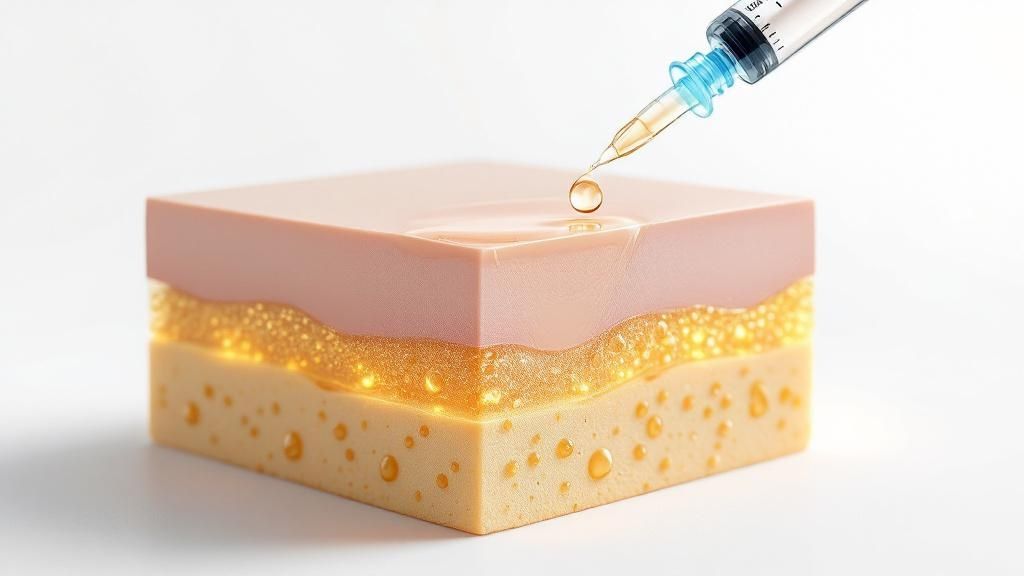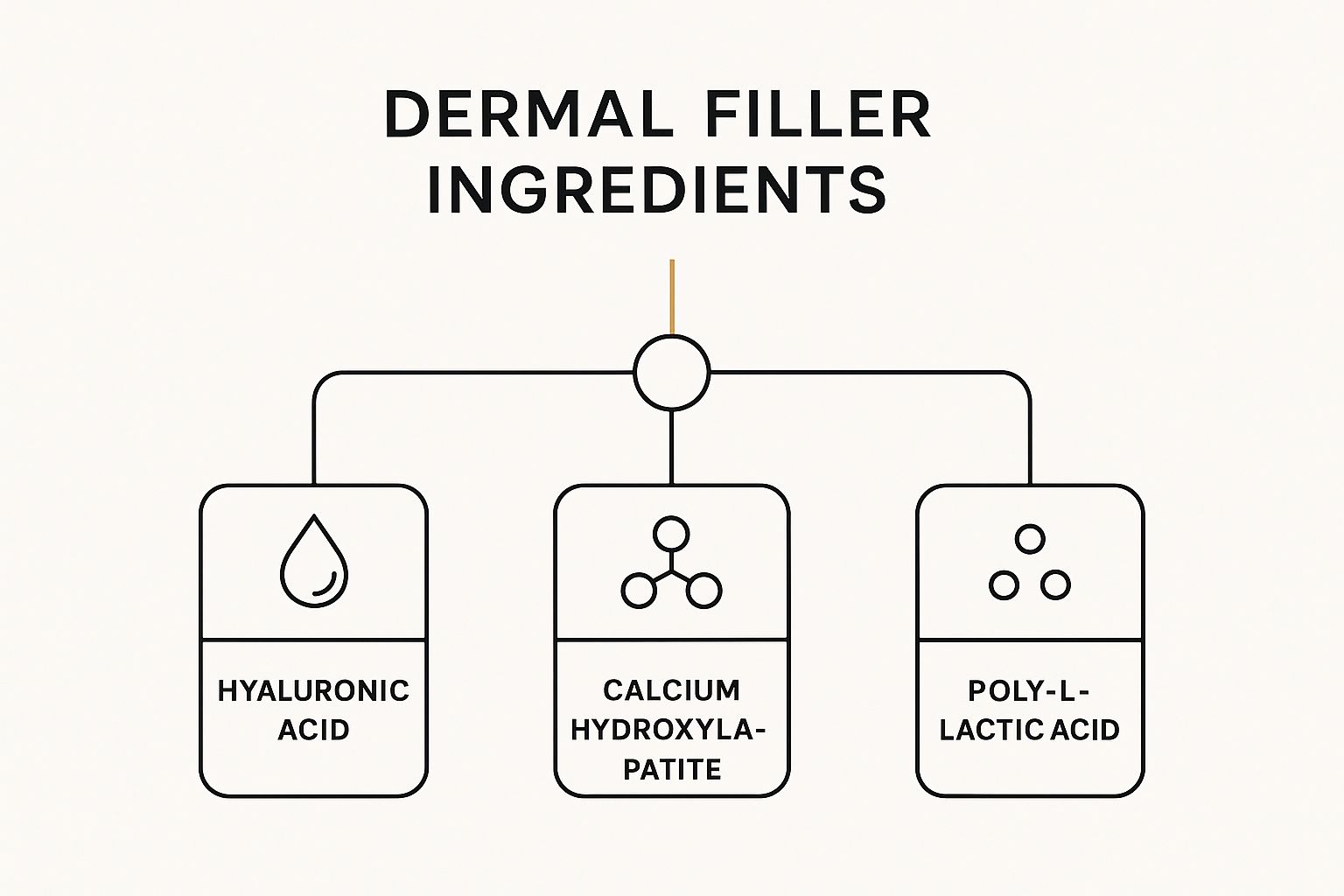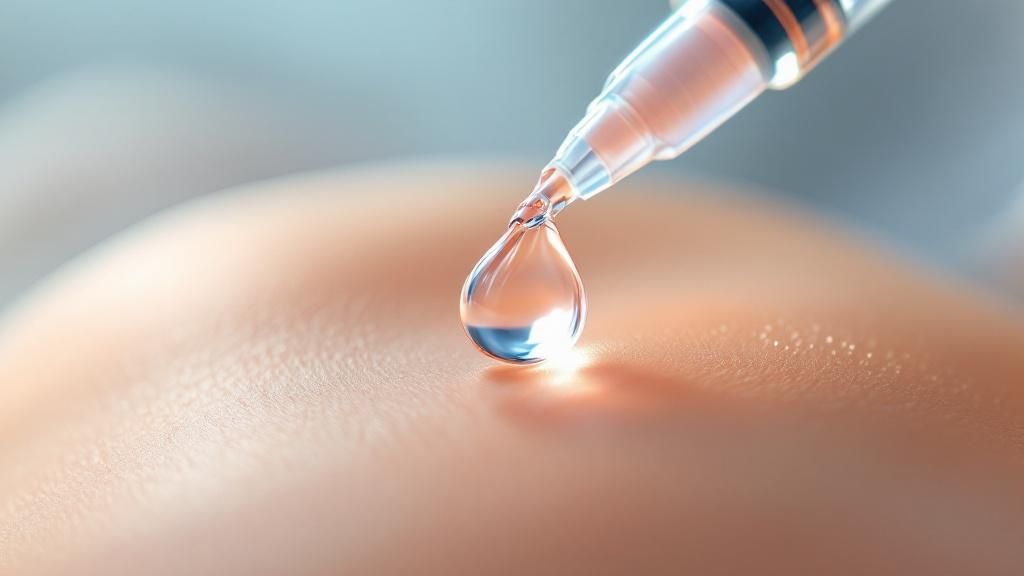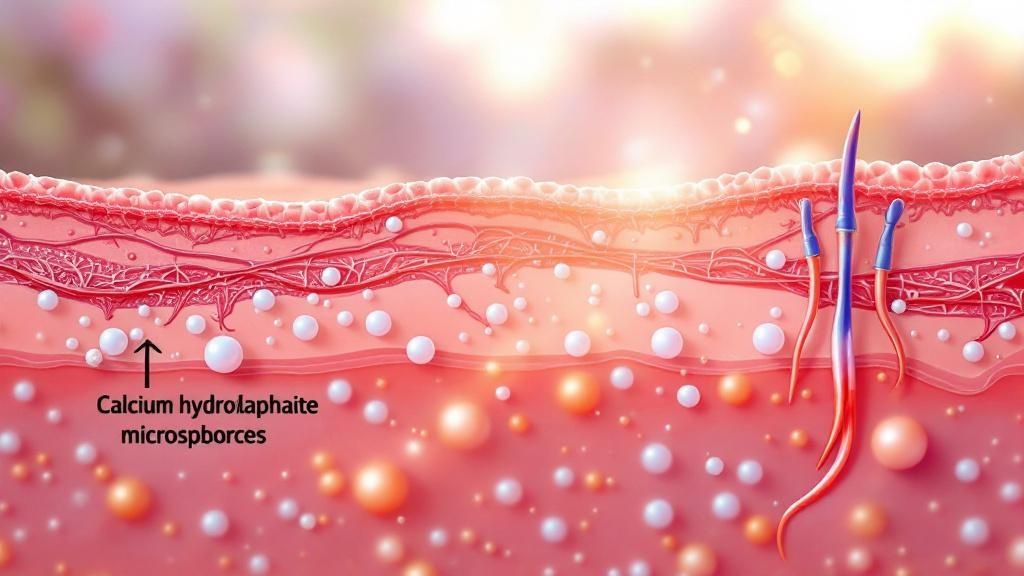
So, what exactly is in that syringe?
Let's get straight to it. Dermal fillers are injectable gels designed to restore lost volume and smooth out lines, but the magic is in what they're made of. The vast majority of fillers on the market today are made from Hyaluronic Acid (HA), a sugar molecule your own body produces naturally.
Think of HA as a tiny, moisture-loving sponge. It attracts and holds onto water, creating that soft, natural-looking plumpness and hydration right from within the skin.
The Core Components Inside Dermal Fillers
When you look beyond the surface of aesthetic treatments, you find some pretty incredible science. Fillers aren't a one-size-fits-all solution; their makeup is specifically engineered to achieve different results, from softening delicate laugh lines to sculpting and defining your cheekbones. Understanding what’s inside is the first step to appreciating just how they work.
At their core, fillers are primarily made from one of four main materials approved for cosmetic use. Research confirms that Hyaluronic Acid (HA) fillers absolutely dominate the global market, and for good reason—the substance occurs naturally in our bodies, making it highly compatible and, importantly, reversible. For more detail, you can check out this dermal fillers market analysis.
The other key players you'll see are Calcium Hydroxylapatite (CaHA), Poly-L-Lactic Acid (PLLA), and the more permanent option, Polymethyl Methacrylate (PMMA).
A Visual Guide to Filler Ingredients
To make these concepts a bit easier to grasp, the diagram below breaks down the main categories of filler ingredients.

This visual shows how different materials form the foundation of modern injectable treatments, with each one serving a very distinct purpose.
What Each Ingredient Is Designed To Do
Each of these substances interacts with your skin differently. It helps to think of them as different tools in an artist's toolkit, each one chosen for its unique properties and the effect it can create.
The choice of filler material is strategic. A practitioner selects an ingredient based on the treatment area's needs—whether that's gentle hydration for delicate lips or robust structural support for prominent cheekbones.
Here's a quick rundown of their primary roles:
- Hyaluronic Acid (HA): This is the ultimate hydration hero. It acts like a sponge, pulling in moisture to plump the skin, fill out wrinkles, and add soft, natural-looking volume.
- Calcium Hydroxylapatite (CaHA): This ingredient does double duty. It provides immediate volume and also stimulates your body’s own collagen production, giving you longer-lasting structural support.
- Poly-L-Lactic Acid (PLLA): Known as a "biostimulator," PLLA is the patient player. It works gradually by encouraging your skin to rebuild its own collagen framework over several months for a very natural-looking result.
- Polymethyl Methacrylate (PMMA): This is a semi-permanent option. It uses tiny, smooth microspheres to create a lasting scaffold that supports the skin for the long haul.
To keep things simple, here's a quick reference table summarizing the key filler ingredients.
Quick Guide to Dermal Filler Ingredients
| Filler Material | Primary Function | Common Treatment Areas |
|---|---|---|
| Hyaluronic Acid (HA) | Hydrates and adds volume | Lips, cheeks, under-eyes, fine lines |
| Calcium Hydroxylapatite (CaHA) | Adds volume and stimulates collagen | Deeper wrinkles, jawline, cheeks |
| Poly-L-Lactic Acid (PLLA) | Stimulates collagen production over time | Nasolabial folds, volume loss in cheeks |
| Polymethyl Methacrylate (PMMA) | Provides permanent structural support | Deep wrinkles, acne scars |
This basic map of ingredients sets the stage for a deeper dive into how each one works to achieve beautiful, tailored results. Now, let's explore them one by one.
Hyaluronic Acid: The Gold Standard Ingredient
When we talk about what dermal fillers are made of, one ingredient is the undisputed champion: Hyaluronic Acid (HA). This isn't some foreign chemical cooked up in a lab; it's a sugar molecule that your body already produces naturally. You'll find it everywhere—in your skin, your joints, and even your eyes.
Its main job? Holding onto water to keep your tissues hydrated and plump.
Think of HA as your skin’s built-in sponge. A single molecule can hold up to 1,000 times its own weight in water, which is exactly why it’s so incredible at restoring lost volume and giving the skin that dewy, hydrated look. Because it's a substance your body already recognizes, HA-based fillers are exceptionally safe and well-tolerated.

Why Not All HA Fillers Are Created Equal
So, if HA is natural, you might be wondering how it sticks around for months after being injected. The secret is a process called cross-linking. In its natural form, your body breaks down HA incredibly fast—sometimes in just a day or two.
To create a gel that lasts, manufacturers link the individual HA strands together, kind of like weaving loose threads into a durable, resilient fabric. This cross-linking creates a stable gel that your body metabolizes much more slowly, giving you results that can last anywhere from six to 18 months.
The degree of cross-linking is what gives each filler its unique personality:
- Low Cross-Linking: This creates a soft, silky, and flexible gel. It's perfect for delicate areas like the lips or for smoothing fine lines where you want subtle, natural movement.
- High Cross-Linking: This results in a thicker, firmer gel that offers more structure and lift. It’s the go-to for sculpting cheekbones, defining the jawline, or filling in deeper folds.
This versatility means an experienced injector can choose the perfect tool for the job. For targeted hydration and subtle plumping, products like the BARB N.P. HydraRevive line offer specialized HA formulations designed for delicate areas like under the eyes and fine lines, showcasing just how adaptable modern fillers have become.
The Ultimate Safety Net: Dissolvability
Maybe the biggest advantage of HA fillers is that they're reversible. Life happens, and aesthetic goals can shift. If you're not thrilled with your results or, in rare cases, if a complication occurs, HA fillers can be dissolved.
A simple injection of an enzyme called hyaluronidase can break down the HA filler, returning the treated area to its original state, often within 24 hours. This feature provides an unparalleled level of peace of mind for both patients and injectors.
This "undo button" is a primary reason why HA fillers are considered the gold standard. They deliver beautiful, natural-looking results with a built-in safety measure that other types of fillers simply can't offer. To get a better sense of the science, you can discover more about how dermal fillers work in our detailed guide and see how these ingredients interact with your skin's biology.
How Collagen-Stimulating Fillers Work
While Hyaluronic Acid fillers are fantastic for adding immediate, pillowy volume, another class of injectables plays a completely different game. These are known as biostimulators, and they do much more than just fill space. Instead, they kickstart your body’s own collagen factory, waking it up to rebuild and rejuvenate from the inside out.
The key players here are ingredients like Calcium Hydroxylapatite (CaHA) and Poly-L-Lactic Acid (PLLA). Don't think of them as instant plumpers. A better way to imagine them is as tiny seeds planted deep beneath the skin. Their main job is to signal dormant cells called fibroblasts, encouraging them to get back to work producing fresh, new collagen.
This approach builds a stronger, firmer support structure for your skin. Over the following weeks and months, the skin gradually rebuilds itself, leading to a lift and firmness that looks and feels completely natural—because it is your own tissue.

Different Paths to Collagen Production
Even though CaHA and PLLA both rev up collagen production, they offer slightly different treatment journeys. Understanding their unique quirks helps clarify what dermal fillers are made of and why one might be chosen over another to meet specific aesthetic goals.
Calcium Hydroxylapatite (CaHA)
Found in fillers like Radiesse, CaHA offers a one-two punch. The formula is made of tiny calcium microspheres suspended in a smooth gel. That gel gives you an immediate lift and volume boost right after injection, so you see a difference before you even leave the office. As your body naturally absorbs the gel over time, the microspheres are left behind, creating a scaffold that triggers ongoing collagen production for long-term improvement. For those seeking this dual-action benefit, the BARB N.P. RadianceLift collection is a leading example of CaHA technology.
Poly-L-Lactic Acid (PLLA)
PLLA, the star ingredient in Sculptra, takes a more patient, subtle approach. It doesn't provide any significant volume on day one. Instead, it works quietly behind the scenes for several months, stimulating collagen growth to gradually restore volume to hollowed areas. This makes it an incredible choice for addressing widespread volume loss in the mid-face or temples for a very natural, gradual restoration.
Biostimulators are ideal for addressing the foundational causes of aging, not just the surface-level symptoms. They help restore the skin’s underlying architecture, leading to durable and natural-looking rejuvenation.
Who Benefits Most from Biostimulators?
Collagen-stimulating fillers are particularly effective for anyone experiencing more significant structural aging. They are often the go-to choice for tackling deeper volume loss in the cheeks, sharpening the jawline, or softening prominent nasolabial folds.
- Candidates for CaHA: Often chosen for those who want both an immediate lift and long-term collagen benefits. It’s excellent for contouring cheeks or defining the jawline.
- Candidates for PLLA: Ideal for patients with more generalized volume loss who prefer a gradual, subtle enhancement that builds beautifully over time.
It's important to remember that while these fillers rebuild structure, they don't address dynamic wrinkles caused by muscle movement. To learn more about how different injectables target different concerns, you can explore the key differences between Juvéderm and Botox.
At BARB N.P., we often combine biostimulators with other treatments to achieve a balanced, full-face rejuvenation. This tailored approach ensures that both volume and expression lines are addressed for the most harmonious result.
What About Permanent Fillers?
Most dermal fillers are designed to be temporary, gradually fading as your body metabolizes them. But what if you’re looking for a solution with serious staying power? For those seeking a long-term fix for specific structural concerns, there’s another category of filler altogether.
This is where Polymethyl Methacrylate (PMMA) enters the conversation. It offers a completely different approach to building volume and support.
Unlike ingredients your body eventually breaks down, PMMA is non-absorbable. It’s made of tiny, biocompatible microspheres suspended in a smooth collagen gel. When injected, that collagen provides some immediate lift, but the real magic happens over the long term.
Building a Permanent Scaffold for Your Skin
The secret to PMMA's longevity lies in those tiny spheres. After the initial collagen gel is absorbed by your body over a few months, the PMMA microspheres stay put. Think of them as a permanent framework or scaffold left behind right where you need it.
This scaffold provides a durable structure that your body’s own collagen can grow around and weave through. This natural process, known as collagenesis, helps secure the implant in place, providing lasting volume and support from within. The result is a semi-permanent correction that can last for years.
PMMA is a powerful tool, but it’s reserved for very specific applications. Its permanence demands an exceptionally high level of precision from the injector, because the results aren't easily reversed like they are with HA fillers.
When Is PMMA the Right Choice?
Because it’s permanent, PMMA is used selectively for challenging issues that other fillers might not adequately address. It’s not a go-to for general plumping or filling fine lines. Instead, its strength is in correcting deep, static wrinkles and structural depressions that need significant support.
Common applications include:
- Deep Nasolabial Folds: Correcting the prominent smile lines that run from the nose to the corners of the mouth.
- Pitted Acne Scars: Filling in deep, indented scars to create a much smoother skin texture.
The injector’s skill is absolutely critical when working with PMMA. Proper placement is everything for a natural, beautiful, and safe outcome. While it’s a powerful option, PMMA is just one specialized tool in the broad landscape of injectables.
To get a clearer picture of how fillers differ from treatments that relax muscles, our guide on dermal fillers vs. Botox offers a great side-by-side comparison. At BARB N.P., we always start with a thorough consultation to determine the safest and most effective material for your unique goals.
The Journey From Collagen To Hyaluronic Acid
To really understand what makes today’s dermal fillers so effective, it helps to look back at where it all started. The story of injectable aesthetics didn’t begin with the sophisticated, smooth gels we use now. The journey actually began back in the 1980s with a completely different material: collagen.
At the time, fillers made from bovine (cow) collagen were a massive step forward. For the first time, there was a real, non-surgical solution for filling in wrinkles and restoring lost facial volume. It gave people a minimally invasive way to address the signs of aging, which was a huge deal.
But those early collagen fillers had some serious drawbacks. Because the material came from an animal, there was a real risk of allergic reactions. This meant every patient had to get an allergy test weeks before their actual appointment, adding an inconvenient and time-consuming step to the whole process.
The Drawbacks Of Early Fillers
Beyond the allergy issue, the results from bovine collagen just didn't last. Patients often saw their improvements fade away in just a few months. That meant frequent, costly appointments to maintain their look, making it an impractical choice for long-term rejuvenation.
The industry desperately needed a better, safer, and more durable alternative. That need is what pushed cosmetic science forward, leading researchers to a substance the human body already produces and trusts.
A New Era Begins With Hyaluronic Acid
The real breakthrough came in the early 2000s with the arrival of Hyaluronic Acid (HA) fillers. This moment completely changed the game in aesthetic medicine. Unlike collagen, HA is biocompatible—our bodies recognize it as a natural substance, which nearly eliminated the risk of allergic reactions and the need for pre-treatment testing.
This was a monumental shift. While collagen was the original go-to, HA fillers quickly took over because of their superior safety profile and much longer-lasting results—typically six to twelve months. Even better, they were reversible with a simple enzyme. This evolution paved the way for the reliable, predictable treatments we have today, and you can see more on the growth of the injectable dermal filler market here.
The move from collagen to Hyaluronic Acid wasn't just a simple product upgrade; it was a fundamental change in philosophy. The focus shifted from introducing a foreign material to working with the body's own biology.
This evolution—from a reactive, short-term fix to a proactive, biocompatible solution—is exactly why HA is still the gold standard in fillers. At BARB N.P., we exclusively use these advanced HA fillers to ensure the safest, most beautiful, and most natural-looking results for our clients.
How Global Trends Shape Filler Innovation
The science that goes into your dermal filler doesn’t happen in a lab vacuum. It’s part of a huge, worldwide conversation about beauty, with different cultures pushing for specific kinds of results. What’s popular in North America might be completely different from the booming aesthetic markets in Asia, creating a dynamic that shapes the next generation of injectables.

This global demand is what fuels the research and development behind new filler formulas. For instance, some markets might prioritize soft, ultra-hydrating fillers that create a dewy, "glass skin" look. In contrast, other regions are driving the creation of firmer, more structural gels designed for sharp, defined facial contouring.
The Rise of the Asia-Pacific Market
While North America and Europe are still major players, the real explosion in growth is happening elsewhere. The Asia-Pacific region is quickly becoming a powerhouse in the aesthetics industry, with an incredible surge in consumer demand and investment.
The numbers really tell the story. Projections show that countries like India and China are on track to grow at impressive rates of 7.6% and 7.1%, respectively, between 2024 and 2034. A rising middle class, combined with major R&D investments, has turned China into one of the largest and fastest-growing dermal filler markets in the world. You can dig into more of the data on these dermal filler market trends to see the full picture.
This global influence means that the filler options available at a trusted clinic like BARB N.P. are the result of an international dialogue. The products we use are constantly being refined based on feedback and clinical data from millions of treatments performed across the globe.
This link between what consumers want and what scientists create is everything. It ensures filler technology keeps moving forward, offering safer, more effective, and more personalized options for all of us. The treatment you get today is better because of the diverse needs of patients everywhere, pushing manufacturers to build a wider, more versatile toolkit of aesthetic solutions.
Still Have Questions About Fillers? Let's Clear Them Up.
After diving into the science, it's totally normal to have a few lingering questions. Making a decision about aesthetic treatments is a big deal, and you deserve to have all the facts.
Here are some of the most common questions we hear from clients, answered in a straightforward way to help you feel confident and informed.
Are Dermal Fillers Actually Safe?
Yes, absolutely. When you're in the hands of a qualified and experienced medical professional, FDA-approved dermal fillers have an incredible safety record.
Hyaluronic Acid (HA) fillers are especially safe for two key reasons. First, HA is a substance your body already makes, so the risk of a reaction is extremely low. Second, if for any reason you're not happy with the result, HA fillers can be dissolved with a simple enzyme injection. It's a built-in safety net.
You might experience some temporary swelling or bruising right at the injection site, but this is usually mild and fades on its own within a few days.
How Do I Know Which Filler Is Right for Me?
This is the million-dollar question, and the answer is completely personal. The best filler for you depends on your unique facial anatomy, the area you want to treat, and your ultimate aesthetic goals.
For example, a soft, flexible HA filler from the BARB N.P. HydraRevive line is perfect for creating a subtle, pillowy enhancement in the lips. But if you're looking to rebuild cheekbone structure and lift, a more robust collagen-stimulator like CaHA might be a better fit.
There's only one way to know for sure: a thorough, one-on-one consultation with an expert injector. They can assess your facial structure, listen to your goals, and design a personalized treatment plan that will deliver the beautiful, natural-looking results you want.
Are Fillers and Botox the Same Thing?
It’s one of the most common points of confusion, so let's break it down. No, they are not the same, though they are often used together for a full-face rejuvenation. They work in completely different ways.
- Neurotoxins (like Botox): Think of these as muscle relaxers. They work by softening the muscle movements that cause dynamic wrinkles, like frown lines and crow's feet. They stop the action.
- Dermal Fillers: These are all about restoring volume. They physically "fill in" static wrinkles, replenish areas that have lost volume over time, or enhance facial contours. They restore the structure.
At BARB N.P., we believe that beautiful results start with a conversation. A personalized consultation is the first and most important step. Book your appointment today to discuss your goals and discover the perfect treatment plan for you.

